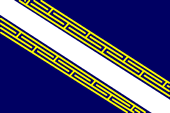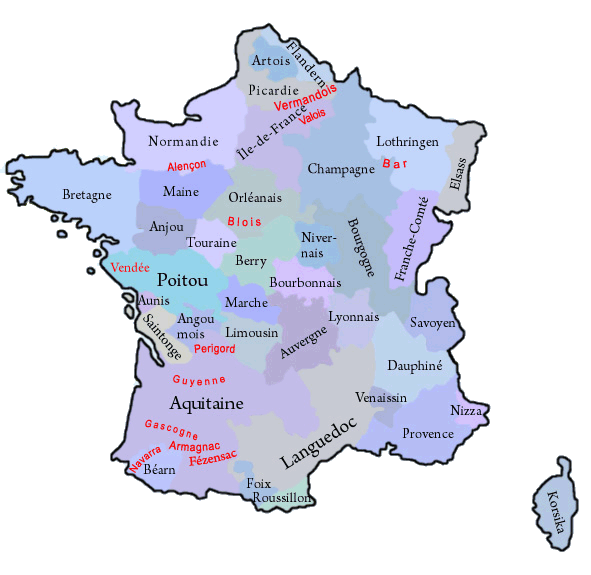mobile View, to the German Version tap the flag


- historical region in France
- former county, duchy and province
• Flag
• Meaning/Origin of the Flag
• Coat of Arms
• Meaning/Origin of the Coat of Arms
• Map of the historical Regions in France
• Explanations about the Regions
• History
• Origin of the Country's Name

Flag of the Champagne
– Drapeau de l' Champagne,
Source, by: Die Welt der Flaggen






The historic flag of the Champagne is a scutcheon flag. Its design displays the image of the coat of arms.
Source:
Volker Preuß,
Heraldique Europeenne


1019–1284,
Coat of arms of the Counts of Blois
– Armoriaux des comtes de Blois,
Source, by:
Wikipedia (DE)

Coat of arms of the Champagne
– Armoriaux de l' Champagne,
Source, by:
Heraldique Europeenne

The coat of arms of the Champagne shows white oblique-right bar on blue ground, which is bounded above and below by golden lines, each topped with a crutch cut. The Heraldry of the coat of arms goes probably back to the Counts of Blois, who were enfeoffed with the Champagne in the year 1020. Their coat of arms became obviously a little bit modified and was transferred to the county.
Source:
Heraldique Europeenne,
Wikipedia (DE),
Volker Preuß

The historical, French Regions:

in black: governorate and province in 1776,
in red: former county, province oder governorate
Map: Volker Preuß

The until the French Revolution existing provinces (or governorates) have been historically grown structures, which had their roots oftenly in former fiefdoms of the French crown, historic counties and duchies. They oftenly existed for hundreds of years and had preserved regionality (e.g. cultural particularities and regional languages). On the occasion of the French Revolution such phenomena were of course not desirable, and as part of their bloody and violent egalitarianism any regional references were eliminated. Shortly after the French Revolution the provinces were dissolved and France became divided into many départements, which should have approximately the same size and the same status. The départements were named after rivers or mountains, to use never and in no circumstances the name of an old province. However, there was no success in cutting the connections of the people of France to their respective regions, so that administrative regions were re-created in 1960, to have a better control in regional administrative processes. In this way became départements, which were placed in a historical province, administratively grouped to an oftenly historically named region. The resulted structures coincide only approximately with the boundaries of the old provinces. In the strictly centralist France any regionality is avoided, so that even the official flags of these regions mostly look like flags of companies, unloving, unhistorical, technocratic and modernistic, and these flags should not be a subject of any lexical considerations here. Only in a few of that regions, exist official flags which remember the historical models. But, even the existence of these today's regions is douptful, because in 2014 was passed a territorial reform valid from the year 2016, that reduces the number of the existing regions by merging to nearly the half. However, there exist unofficial flags in nearly all of these regions, which should remember the old provinces and the old heraldry.
Wikipedia Link to the regions of France:
click or tap here
FOTW Link to the regions of France:
click or tap here
Source: Flags of the World,
Wikipedia (D),
Volker Preuß

antiquity · settlement by the Celtic tribes of the Remers, Trikasse, Meldes, Lingones and Sennones
55 B.C. · Roman conquest, annexation to the Roman Empire, to the provinces of Gallia Belgica and Gallia Lugdunensis
4th to 5th century A.D. · Great Migration, today's Champagne is populated by Franks but also by Burgundians
451 · Battle of the Catalaunian Fields, the Roman general Flavius Aetius stops the advance of the Huns under Attila
5th century · emergence of the Frankish Kingdom around the city of Doornik (Tournai, now in Belgium) under kings out of the House of the Merovingians, to 507 (under King Clovis) expansion of the empire to the Atlantic Ocean, the Pyrenees and the Alps
511 · death of King Clovis, division of the Frankish Empire by Salic law of succession among his four sons (residences in Paris, Soissons, Orleans, Reims)
550 · administrative division of the kingdom into the kingdoms of Austrasia, Neustria and Burgundy, today's Champagne comes to Austrasia
570–714 · reign of by the King appointed dukes in the Champagne
639 · death of King Dagobert I., the power goes over to the Mayors of the Palace (maior domus) of Austrasia (House of the Carolingians)
687 · Pepin II. asserts itself as Mayor of the Palace throughout the Frankish Empire
751 · Pepin the Short (III., grandson of Pepin II.) eliminates the Merovingian monarchy and let hisself elect to the king from the Franks
946 · the Champagne, now consisting of the Counties of Troyes and Meaux, is given as a fief to the Counts of Vermandois
1019/25 · the Counts of Blois receive the Counties of Troyes and Meaux as a fief
1107–1152 · reign of Theobald IV, the Great, from the House of Blois, the Counties of Troyes and Meaux are merged to the County of Champagne
1284 · King Philip IV. of France (from the House of the Capetingians) marries Joan, the heiress of the Kingdom of Navarre, the County of Champagne and the County of Brie, and brings this possessions to the French crown, they became annexed to France in 1361, the Champagne and Navarre could retain certain privileges, partly to the Revolution of 1789, the Champagne as a governorates (province), Navarra as the corporative state
1468 · King Louis XI. of France transfers to his brother, Charles de Valois, Duke of Berry, the Champagne, together with the title of the Duke of Champagne
1776 · the already in the 14th century created governorates of the civil administration of the kingdom of France become committed to a number of 39, and correspond in this way to the number of provinces, in previous years could any provinces be summarized in one governorate
1789 · French Revolution , the governorates (provinces) become abolished, the Champagne is divided into departments
1960 · reintroduction of regions in France, formation of the Region of Champagne-Ardenne, but not within the historic boundaries, just by integrating the departments of Ardennes, Marne, Aube and Haute Marne
2016 · the Champagne-Ardenne region merges with the Alsace (Elsass) and Lorraine (Lothringen) regions in the new, larger region of Greater East (Grand Est)
Source:
Meyers Konversationslexikon,
Wikipedia (DE),
Taschenatlas Weltgeschichte

The name "Champagne" is a reference to the agricultural nature of the land, which is not only known for wine and champagne. The name of the Champagne derives from the Latin word "campus", what "field" means, and came upon the old French word "champs" in its shape.
Source:
Wikipedia (DE),
Volker Preuß


![]()








